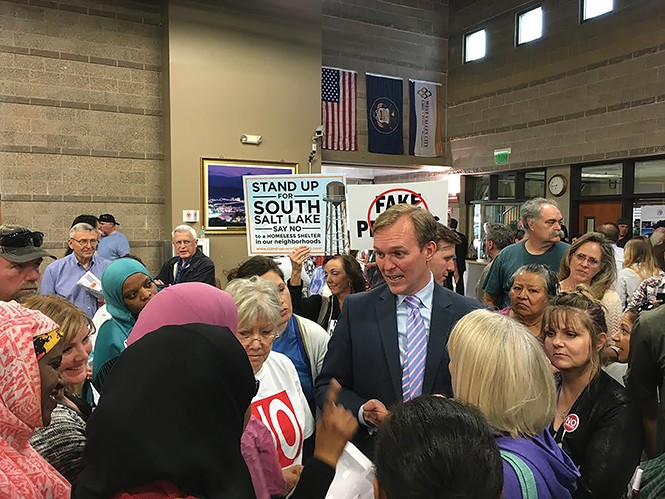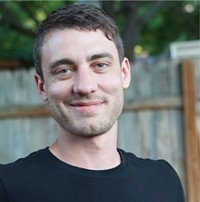Give Them Shelter
Salt Lake County aims, struggles to learn from SLC's homeless facilities debacle.
By Dylan Woolf Harris @dylantheharrisFor a moment, at the center of a huddle, questions were foisted upon Salt Lake County Mayor Ben McAdams faster than he could dish out responses. Inside the Utah Cultural Celebration Center on March 21, residents of West Valley City and South Salt Lake had circled around the mayor and demanded to know, for example, whether he would tolerate homeless folks milling about in his neighborhood, why the southern end of the valley didn't have a shelter and whose tax dollars were at stake.
It was an informal county-hosted open house regarding the proposed site for a new homeless shelter. Ten days earlier, the county revealed five addresses under consideration, but only one would be picked. Per a state timeline, they had nearly until the end of the month to suggest which spot would serve as the new location. Leading up to that deadline, McAdams and his staff called for public input, and residents, such as those gathered at the community center, didn't hold back.
The place was packed. The mood was acerbic. McAdams looked tired.
And if the pins and "No" shirts weren't relaying the message forcefully enough, attendees also waved signs that read "Fake Process," "Stand up for South Salt Lake" and "Think Again Ben."
At one point, with folded arms, McAdams looked a concerned constituent in the eyes, then quickly glanced up at a bouquet of signs that had sprung up in the back of the crowd before turning to another person who called out a different question.
The mayor's reply was simple and circumspect: "We are listening." Those in the outer ring of the crowd were irritated that they could hear neither the questions nor the answers. But, for what it's worth, residents commended McAdams for engaging the public. He continued the interaction, trying to clarify or refute or address inquiries until a call on a cell phone whisked him away.
It was déjà vu. Not three months prior, David Litvack, a senior member of Salt Lake City Mayor Jackie Biskupski's administration, was centered in a strikingly similar scene during an open house at Salt Lake Community College. At that time, the city had planned to build four new homeless resource facilities, which set off alarm bells in the nearby neighborhoods—most loudly for those adjacent to Sugar House's quiet Simpson Avenue. (Two of the four proposed shelter sites—653 Simpson Ave. and 648 W. 100 South—were later dropped from consideration.)
In addition to protesting a potential homeless site next door, residents berated the city for deciding where the shelters would go without soliciting their input. When asked
She might have been on to something. When McAdams' team selected five spots for a potential site and asked the public to help pick which should have a homeless shelter, it didn't take residents in West Valley City and South Salt Lake long to figure out that all five proposals were in their two communities.
Throughout the public comment process, residents repeatedly wondered why not Sandy, Draper, Midvale, Murray, Taylorsville, Millcreek, Cottonwood Heights, the Jordans?
Rep. Craig Hall, R-West Valley City, shares with his constituents a nagging feeling that the search was too narrow. Salt Lake County encompasses a vast valley, after all, but only spots in those towns were being considered.
"I would have preferred to have more site locations throughout different areas of the county, maybe some proposed locations in the south of the county, some proposed locations
Selection of the sites was guided by a set of criteria, including proximity to public transportation, grocery availability and whether a homeless service center would "fit in" with the neighborhood.
The reason why South Salt Lake and West Valley City matched the core criteria has nothing to do with the region's socioeconomic makeup or racial diversity, as alleged by more than one resident at a public meeting. What makes sites in those two towns viable, McAdams tells City Weekly, is the proximity to downtown Salt Lake, where a cluster of the necessary services
With that in mind, the county had been in contract negotiations to some degree on nearly 20 sites, according to the mayor, including in Millcreek and Murray.
"We weren't able to acquire those sites for one reason or another," he says.
Midvale, relevantly, has a homeless shelter originally opened for emergency overflow. The 300-bed facility at 529 W. 7300 South is owned by Shelter the Homeless and operated by The Road Home, the same nonprofit that runs a large 1,000-bed shelter on Rio Grande Street in downtown Salt Lake City.
The facility was rebuilt in 2015 and began operating year-round to serve homeless families.
Unlike the picture outside the Salt Lake City shelter, which is talked about as if it were the abominable poster child of homelessness, the Midvale center is less often mentioned.
Midvale City Councilman Paul Glover says, however, the homeless center in his town is a frequent source of complaints from businesses and residents.
"There is a lot of
Ross Equipment Co. is a heavy machinery business about a block away from the Midvale shelter. Clayton Berg,
In addition to finding needles and pipes on his property, late-night loitering and "using the front grass area as a toilet," Berg says someone set up a makeshift sleeping area on company grounds, the inhabitant of which was likely kicked out of the shelter for violating the rules, police told him.
"Having this person sleeping on our property is a huge safety concern for me as oftentimes our employees are leaving at random times alone," he writes in an email.
Not all businesses close to the Midvale shelter claim to be impacted by homelessness in the region.
Scott Olson,
"It could have been anyone," he says.
McAdams says the Midvale shelter is only comparable in its size to the proposed centers, and it shouldn't be looked at as an example of what to expect from the proposed shelters. It doesn't offer services like mental health counseling, for example, that are integral pieces of the new program.
Skepticism abounds, though. Many believe the city and county have too much faith that the new model will be successful. Public servants are concerned that a new resource center will stretch their departments thin, as Midvale's District 2 councilor contends.
Speaking to City Weekly, John Evans and Ron Morris—the West Valley City and South Salt Lake fire chiefs, respectively—say a new shelter would demand attention beyond what their departments could handle.
"There's no 'might not.' We don't have the resources to cover a homeless center," Evans says. Morris estimates the calls would go up by 1,000 with a homeless shelter in town. "We can't sustain that. Our stations are busy as it is."
A spike in emergency calls requires a larger city payroll, Evans adds, which demands funds. "And the taxpayers probably don't want to pay more taxes."
Even more infuriating to South Salt Lake, the city already has a small center for chronically homeless.
When the county added a couple more potential sites there, Mayor Cherie Wood decried the decision. She said her small city was overburdened with facilities that generate no
"South Salt Lake has all of the facilities that no one wants and none of the county facilities that everyone wants," Wood announced to the press last week. "No county recreational centers, no nice new parks, no new libraries. It's simply not fair."
The message her city wishes to convey, she said, isn't "Not in my backyard" but rather "My backyard is full."
The county has welcomed suggestions for sites, and the two additional South Salt Lake plots were added as a result of public input, according to McAdams.
On March 22, the Site Evaluation Committee, chaired by McAdams, took formal comments from citizens who filled a chamber room in the Senate Building, as well as two overflow rooms. For the next three hours, the committee heard variations of the same message: Don't do this. Not here. It will be ruinous to our businesses. Don't put our families at risk.
Roundly, residents also said they have compassion for the needy and agree that there needs to be a better system in place. Homelessness is among the most pressing issues in Salt Lake City and, by extension, the state.
Legislation that was passed on the last day of this session and signed by Gov. Gary Herbert to appropriate about $10 million for the homeless resource centers was met with very little opposition in the statehouse. The same legislation stops cities from blocking construction of a homeless shelter within their borders.
Rep. Angela Romero, D-Salt Lake City, said she doesn't regret supporting the bill, but clarified that she did so with a presumption that the selection committee wouldn't focus on a relatively small area.
"I thought when we voted for that bill that we would disperse this throughout the
Romero said, though, that neighborhoods are turning against one another because of a portrait of homelessness that is generalized and conflated. "Not everyone that is homeless is a criminal. Many women who've left domestic violence situations are homeless.
The committee has until Thursday to decide where the new center will be constructed.
Speaking to City Weekly last week, McAdams said he fully expected the board to pass on a recommendation to the Legislature by that deadline.
"We're proud that, even considering the tight time frame, we've been able to have a robust public process and this decision will be made transparently," he says.
Highlighting the time crunch, days before a decision was due, McAdams held a news conference on Tuesday to announce two more potential sites in Draper—one at 15001 Minuteman Drive and another on
McAdams said it was too early to say whether the new sites were frontrunners, but added that the support of a city partner is an important
The Road Home Executive Director Matt Minkevitch understands the complexities of homelessness more than just about anyone. He also understands the trepidation people feel when they picture a homeless shelter on their street. Problems at the shelter get the most ink and B-roll, he says, and portray the most visible examples of human suffering—a condition most are fortunate enough not to experience, but no one is immune to.
To end
"If we have more deeply affordable housing and access to services, there will be fewer people in shelters," he says. "This isn't pie-in-the-sky [thinking]."
Below is an interactive map with each of the eight new proposed locations being considered for homeless shelter sites in South Salt Lake, West Valley
More by Dylan Woolf Harris
-
Dabakis Is Leaving the Building
Ever boisterous and outspoken, state senator says lending liberal voice trumps his bill tally.
- Apr 4, 2018
-
Gagged and Bound
Row between South Salt Lake and muralist gets the burlesque treatment.
- Mar 21, 2018
-
Inland Port Authority Update
Gov. Herbert signs contested bill into law.
- Mar 16, 2018
- More »
Latest in News
Readers also liked…
-
Raise a glass for E.L.T Harrison, architect of the Beerhive building on Main
Small Lake City
- Oct 11, 2023







